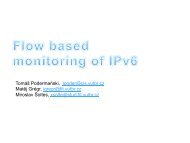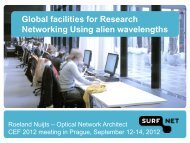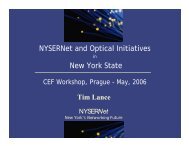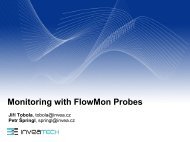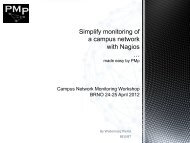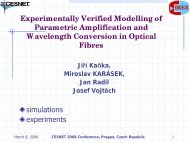2002 - cesnet
2002 - cesnet
2002 - cesnet
Create successful ePaper yourself
Turn your PDF publications into a flip-book with our unique Google optimized e-Paper software.
The actual computing capacity of MetaCentrum is formed by clusters and IntelPentium processors (architecture IA-32), purchased in 2000 and 2001 (in 1999,a high-capacity tape library was purchased, providing a total of 12 TB onlineuncompressed capacity for data backup for all nodes of MetaCentrum). Allclusters include dual-processor units in rack design, with the capacity of 1 GBcentral memory per unit. Each cluster is formed by 64 Intel Pentium III processors,with a frequency of 750 MHz and 1 GHz. The capacity of the disk is 18 × 9 GBand 18 × 18 GB.At the turn of <strong>2002</strong>/2003, a new cluster will be supplied, again with 64 processorsin a dual CPU rack design (height 1U), with Intel Pentium 4 Xeon processors,frequency 2.4 GHz and the disk capacity of 18 × 36 GB (the price for each clusteris gradually decreasing, even though the performance and the disk capacityincreased, as well as the capacity of the network connection – see below). Thiscluster is produced by HP (same as the cluster purchased this year); however,there were some complications concerning the delivery period this year.In 2001, 128 cluster processors were divided among ZČU, CESNET and MU, inthe ratio 32:32:64. Towards the end of the year, 32 of the processors purchasedin 2000 were moved to Prague and new processors will be installed in Brno. In2003, the distribution of MetaCentrum’s performance will be 32:64:96.Even though these systems are physically separate, all clusters will be logicallyequipped with the same version of Linux OS (distribution Debian) and administeredby the PBS system. In early <strong>2002</strong>, a licence was purchased (using the MUfunding) for the extended version of PBSpro, which is gradually replacing theprevious PBS system (complete replacement will be finished in 2003). All clusternodes are separately addressable and accessible directly from the Internet.However, extensive (long-term) utilization of the nodes is possible only throughthe PBS system, in order to enable optimal planning of resources.All cluster nodes were equipped with Fast Ethernet interfaces (100 Mbps). Forhigh-speed transmissions, there were Myrinet high-speed networks available inBrno and Plzeň (always 16 nodes) and a Gigabit Ethernet (16 nodes in Brno).The PBS batch system also enables the selection of nodes with a particular highspeedinterconnection, and users can thus easily choose the required characteristicswithout having to know the exact placement of particular nodes.In the cluster purchased in <strong>2002</strong> (to be installed in 2003), each unit includestwo integrated Gigabit Ethernet interfaces. We therefore decided not to extendthe Myrinet network and purchased HP ProCurve 4108gl switches with 90 GEinterfaces. Together with the existing GE switch, this will enable us to link all48 units (96 processors) in Brno to the GE network (of this, 32 units will belinked through dual GE connection). We will thus create the largest cluster inthe Czech Republic with such a fast interconnection.High-speed National Research Network and its New Applications <strong>2002</strong>97



